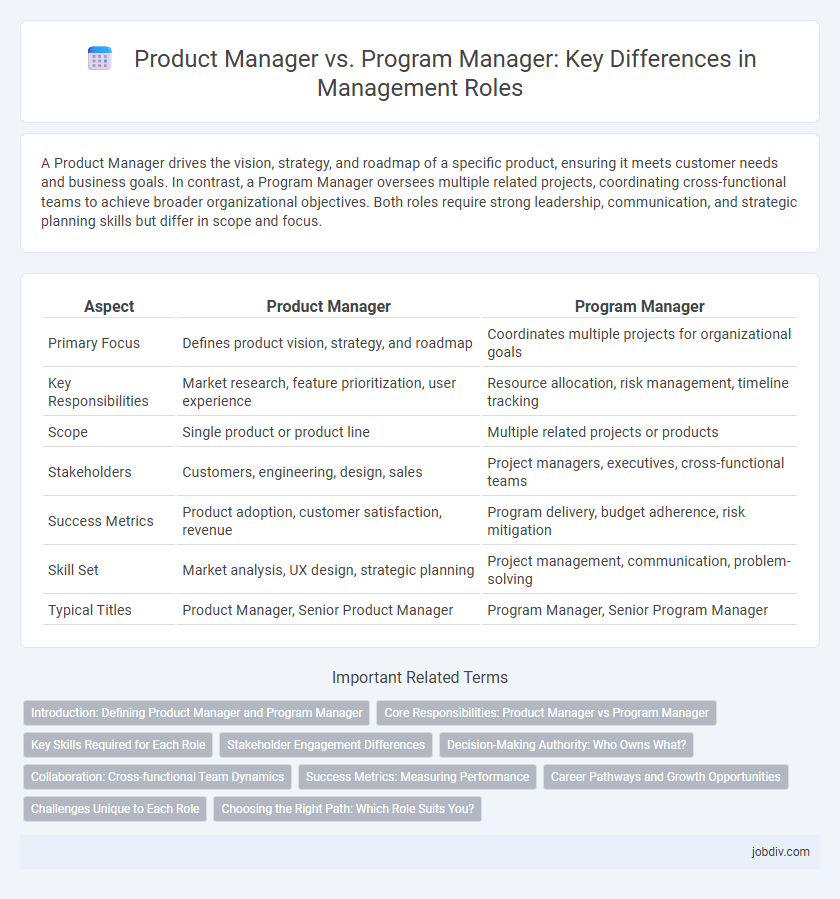A Product Manager drives the vision, strategy, and roadmap of a specific product, ensuring it meets customer needs and business goals. In contrast, a Program Manager oversees multiple related projects, coordinating cross-functional teams to achieve broader organizational objectives. Both roles require strong leadership, communication, and strategic planning skills but differ in scope and focus.
Table of Comparison
| Aspect | Product Manager | Program Manager |
|---|---|---|
| Primary Focus | Defines product vision, strategy, and roadmap | Coordinates multiple projects for organizational goals |
| Key Responsibilities | Market research, feature prioritization, user experience | Resource allocation, risk management, timeline tracking |
| Scope | Single product or product line | Multiple related projects or products |
| Stakeholders | Customers, engineering, design, sales | Project managers, executives, cross-functional teams |
| Success Metrics | Product adoption, customer satisfaction, revenue | Program delivery, budget adherence, risk mitigation |
| Skill Set | Market analysis, UX design, strategic planning | Project management, communication, problem-solving |
| Typical Titles | Product Manager, Senior Product Manager | Program Manager, Senior Program Manager |
Introduction: Defining Product Manager and Program Manager
A Product Manager drives the vision, strategy, and lifecycle of a specific product, focusing on customer needs, market trends, and feature development. A Program Manager oversees the coordination and execution of multiple related projects, ensuring alignment with organizational goals and managing cross-functional teams. Both roles require leadership and strategic planning but differ in scope; Product Managers concentrate on product success, while Program Managers emphasize program delivery and integration.
Core Responsibilities: Product Manager vs Program Manager
Product Managers drive product vision, strategy, and roadmap by gathering customer insights, defining features, and prioritizing development to deliver value and meet market needs. Program Managers coordinate multiple related projects, ensuring alignment with business objectives, managing timelines, risks, and cross-team communication to achieve strategic goals efficiently. While Product Managers focus on the what and why of a product, Program Managers oversee the how and when across broader initiatives.
Key Skills Required for Each Role
Product Managers require strong skills in market research, customer insight analysis, and roadmap prioritization to define product vision and drive feature development. Program Managers excel in cross-functional coordination, risk management, and strategic communication to ensure successful delivery of multiple interrelated projects. Both roles demand proficiency in stakeholder management and agile methodologies but differ in focus--product innovation versus program execution.
Stakeholder Engagement Differences
Product Managers prioritize direct engagement with customers and sales teams to gather detailed user feedback and shape product features, while Program Managers focus on coordinating cross-functional teams and aligning various project stakeholders to ensure seamless delivery and strategic objectives. The Product Manager acts as the voice of the customer, driving product vision and feature prioritization through continuous interaction with external and internal stakeholders. In contrast, the Program Manager manages communication channels among leadership, engineering, marketing, and operations to resolve dependencies and maintain alignment across multiple projects or initiatives.
Decision-Making Authority: Who Owns What?
Product Managers hold decision-making authority over product vision, features, and customer experience, ensuring alignment with market needs and business goals. Program Managers oversee cross-functional project execution, managing timelines, resources, and risk mitigation without owning the product direction. Clear delineation of decision rights between these roles enhances collaboration and project success within management frameworks.
Collaboration: Cross-functional Team Dynamics
Product Managers drive product vision by aligning stakeholders and prioritizing customer needs, fostering collaboration with engineering, design, marketing, and sales teams. Program Managers coordinate multiple projects across teams, ensuring timely delivery and resource allocation while facilitating communication between cross-functional units. Effective collaboration between Product and Program Managers enhances team dynamics, streamlining workflows and accelerating product success.
Success Metrics: Measuring Performance
Success metrics for Product Managers typically center on product adoption rates, customer satisfaction scores, and revenue growth linked to specific features or releases. Program Managers are evaluated based on cross-project delivery timelines, resource allocation efficiency, and overall impact on strategic objectives across multiple initiatives. Both roles require tailored KPIs to accurately reflect their distinct scopes in driving organizational success.
Career Pathways and Growth Opportunities
Product Managers typically advance by deepening domain expertise and leading increasingly complex product lines, moving toward roles like Senior Product Manager, Group Product Manager, and eventually Head of Product or Chief Product Officer. Program Managers often progress by enhancing cross-functional leadership skills, overseeing larger and more strategic programs, advancing to roles such as Senior Program Manager, Director of Program Management, or VP of Program Management. Both pathways offer growth through expanded responsibilities, strategic influence, and leadership opportunities within product development and organizational execution.
Challenges Unique to Each Role
Product Managers face the challenge of defining clear product visions and prioritizing features based on customer needs and market trends, often navigating ambiguous requirements and balancing stakeholder demands. Program Managers must coordinate multiple interrelated projects, managing dependencies and aligning diverse teams to ensure timely delivery and strategic coherence across the program. Both roles require strong communication and leadership skills, but Product Managers emphasize customer-centric innovation, while Program Managers focus on cross-functional execution and risk mitigation.
Choosing the Right Path: Which Role Suits You?
Choosing between a Product Manager and a Program Manager hinges on your passion for either driving product vision or orchestrating cross-functional project execution. Product Managers focus on market research, defining product features, and aligning with customer needs, while Program Managers excel in coordinating multiple interrelated projects, ensuring timely delivery and stakeholder communication. Assess your strengths in strategic product leadership versus operational management to determine the best career path that aligns with your goals and skills.
Product Manager vs Program Manager Infographic

 jobdiv.com
jobdiv.com